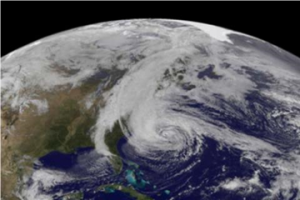
Are you concerned about your health after severe wet weather has caused your home and/or things in your home to smell moldy??? – UCONN workshop on Nov 14th
by Paula Schenck, MPH, University of Connecticut Health Center
Living things need food, water, and a comfortable temperature to grow. Mold, the common name for fungi, can find food in almost anything organic in your home; and because there are so many types of mold that thrive in a broad range of temperature, mold needs only water to begin growing. Many materials –wallboard, fabrics themselves (clothes, curtains) and those that trap dust (carpet) are a grand meal for mold. Even some well-constructed buildings that haven’t had moisture concerns in the past become wet from wind-driven rain and flood waters in severe storms. Once you note mold inside, what does that mean to you? Mold in indoor environments indicates moisture is available for biological growth. Studies have shown that with more water, you should be more concerned about the possibility for severe respiratory illness. Even after flood waters subside, water/moisture is left in materials and encourages life to grow-mold and bacteria. When you see mold on walls or “mildew” as part of fabrics, and/or smell that musty tell-tale odor, you are at risk for illnesses associated with moisture. Mold may be: 1) a direct factor influencing illness, 2) an indicator of other biological agents and bioaerosols that grow in conditions of excessive moisture, or 3) acting on building materials to release chemicals and dusts that could affect your breathing health.
There is much confusion about mold and health with equal measures of uncertainty and concern over indoor exposure to “toxic mold”. However with responsible information from sources such as World Health Organization’s 2009 report and EPA’s internet site on Mold Resources http://www.epa.gov/mold/moldresources/l), it is clear that it is important to recognize the hazard from mold exposure (toxic or not)! Not everyone has the same level of health risk –children, the elderly, and those with breathing conditions or immune disorders are likely vulnerable-, but others are also of concern. So it is important for everyone to: 1) recognize the mold growing inside as a hazard; 2) protect yourself and others by either avoiding the environment or by using the right clothes and equipment when you are cleaning up after storm events or fixing the water damage in your home; and 3) plan well and use methods in re-building your homes that recognize the risk from moisture intrusion, so that the buildings will better withstand the next storm—and contribute to a resilient community.
In the fall 2013, the Center for Indoor Environments and Health began work on – Recovery from catastrophic weather: mold exposure and health-related training (funded under the Centers for Disease Control and Prevention’s National Institute for Occupational Safety and Health (NIOSH) Hurricane Sandy Cooperative Agreement 1U01OH010627-01. This blog is solely the responsibility of Paula Schenck and does not necessarily represent the official views of NIOSH) – Through this project a UCONN team is working to provide information about mold, health and how to reduce consequences from mold exposure for emergency and recovery respondents and communities affected by Hurricane Sandy. Send Paula an email at schenck@uchc.edu to learn about our first free workshop on November 14th.
For questions or more information, please contact
Paula Schenck, MPH
Center for Indoor Environments and Health http://www.oehc.uchc.edu/CIEH.asp
Division of Occupational and Environmental Medicine
University of Connecticut Health Center
The Exchange, Suite 262: 270 Farmington Avenue
Farmington, CT 06032
860-679-2368
schenck@nso2.uchc.edu